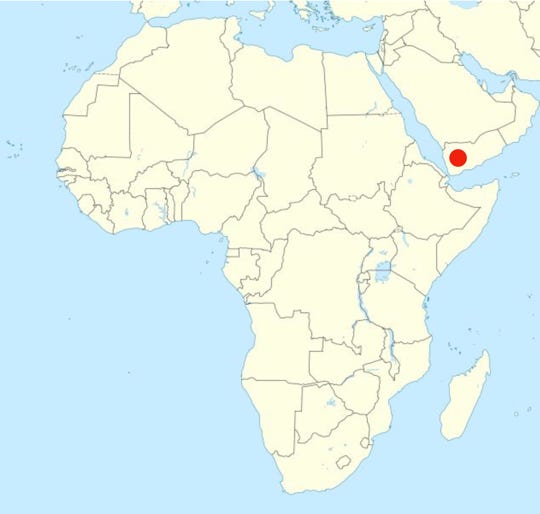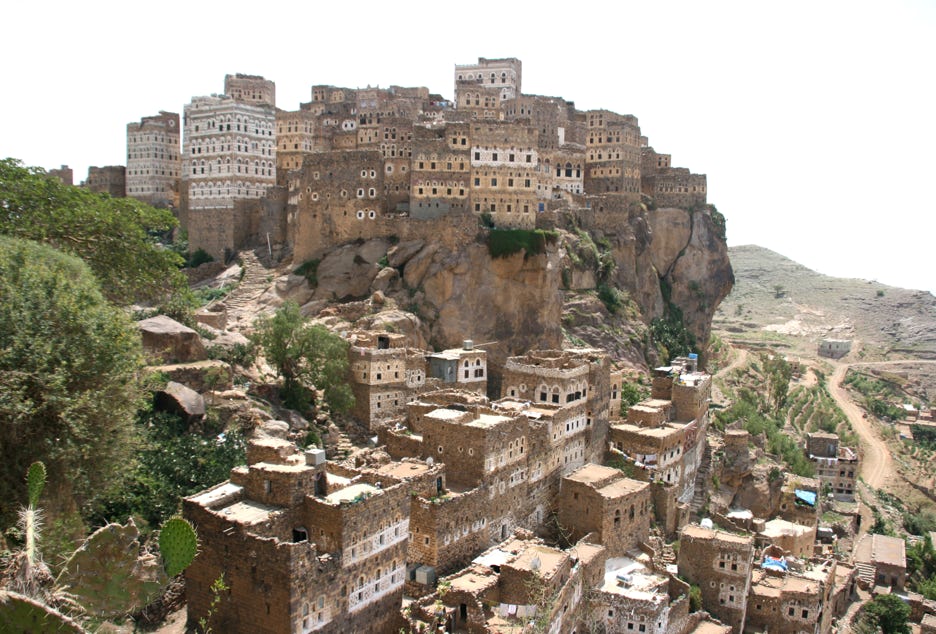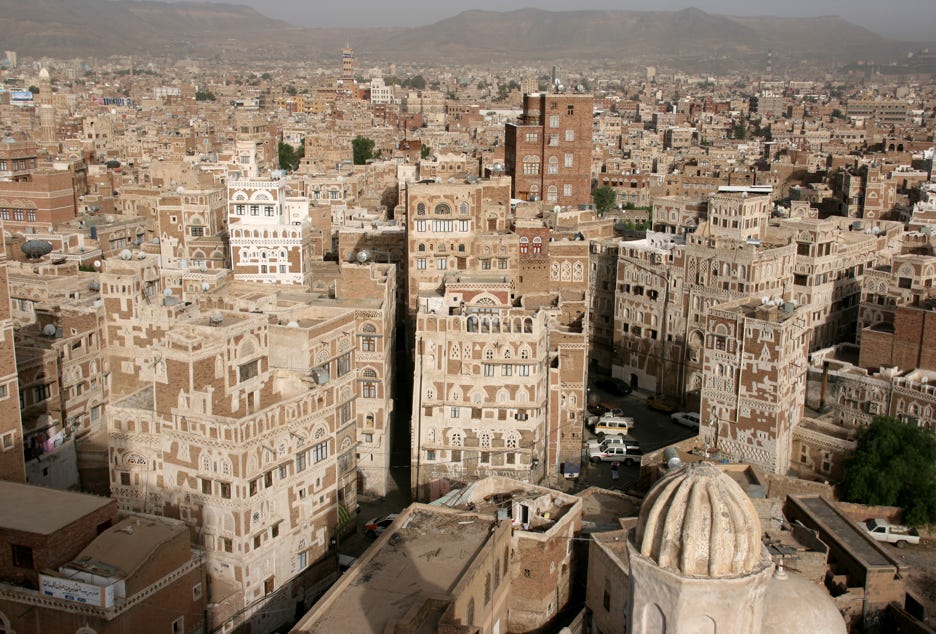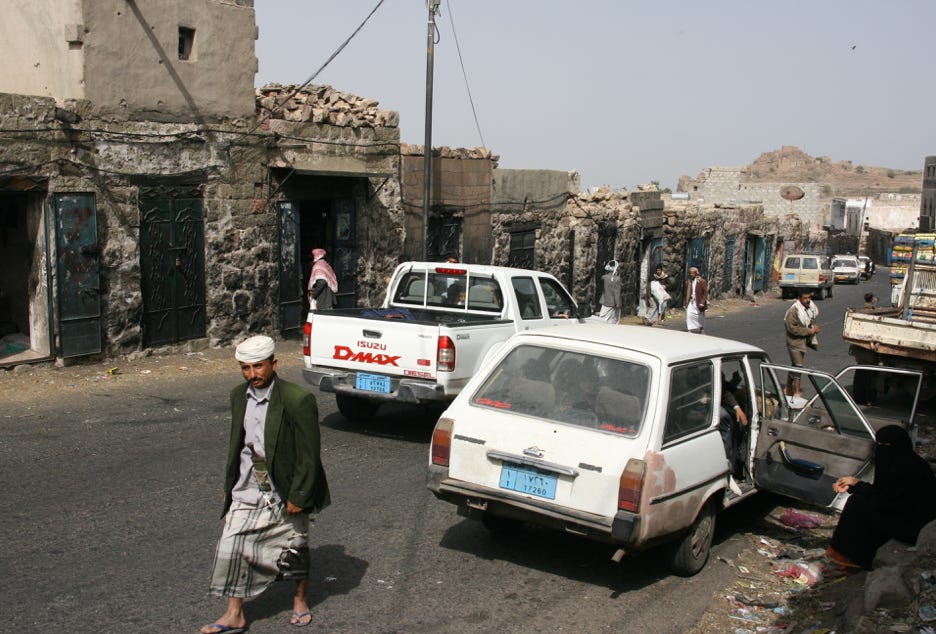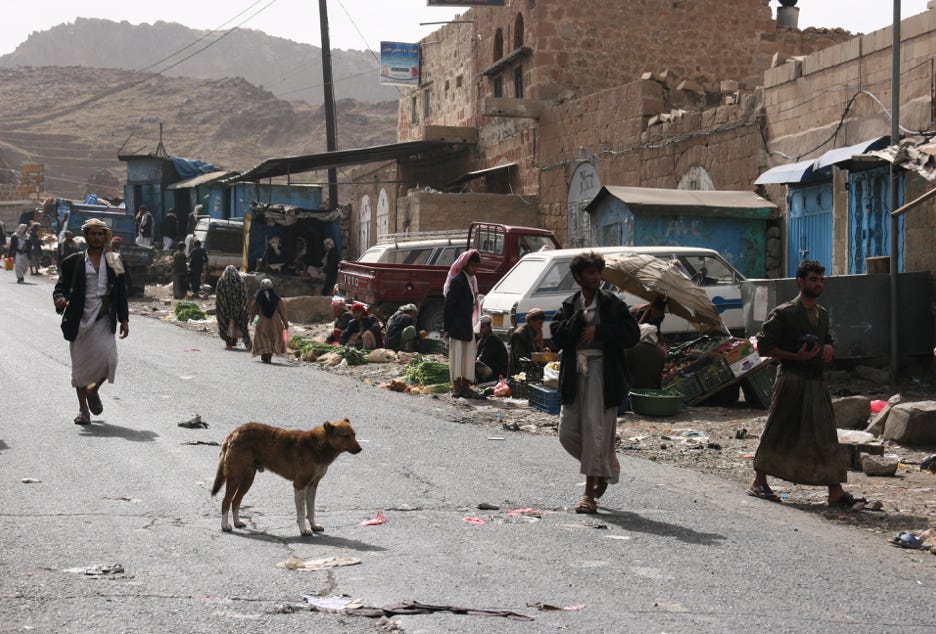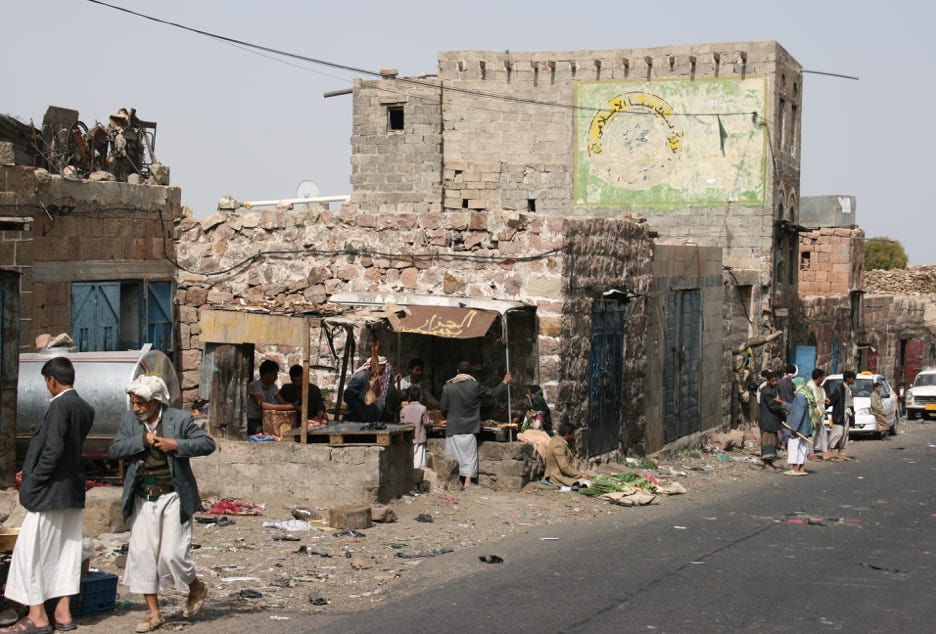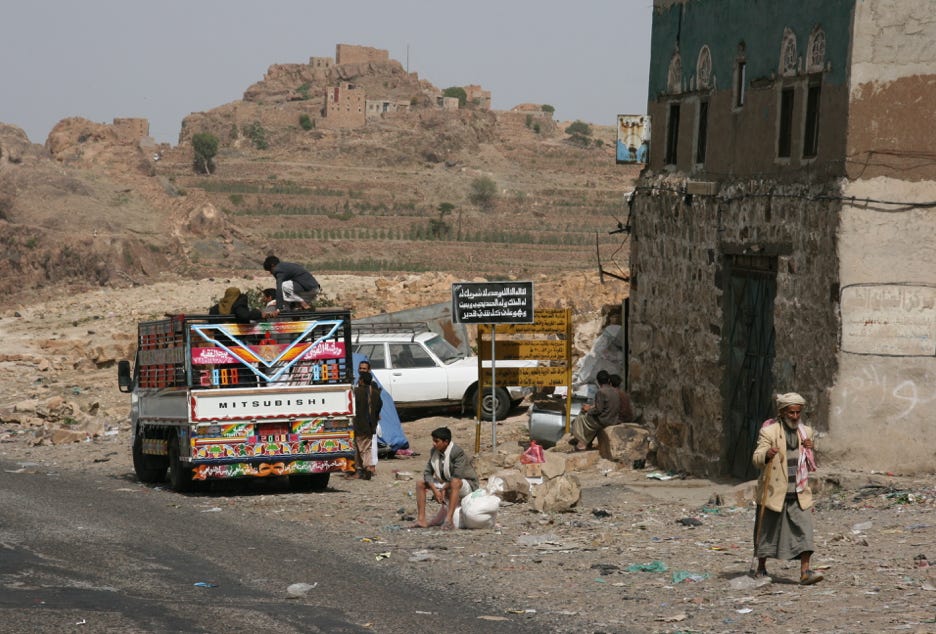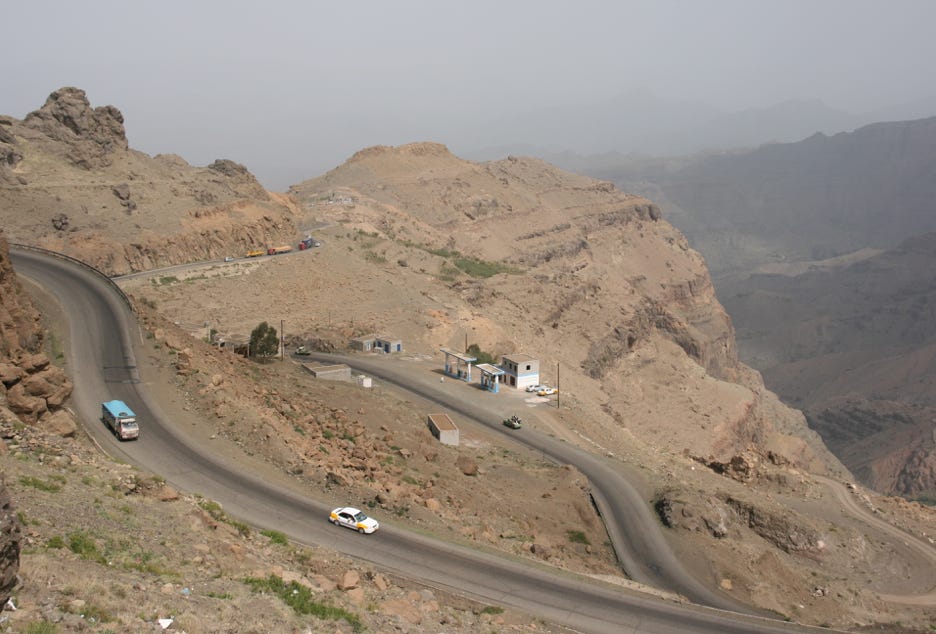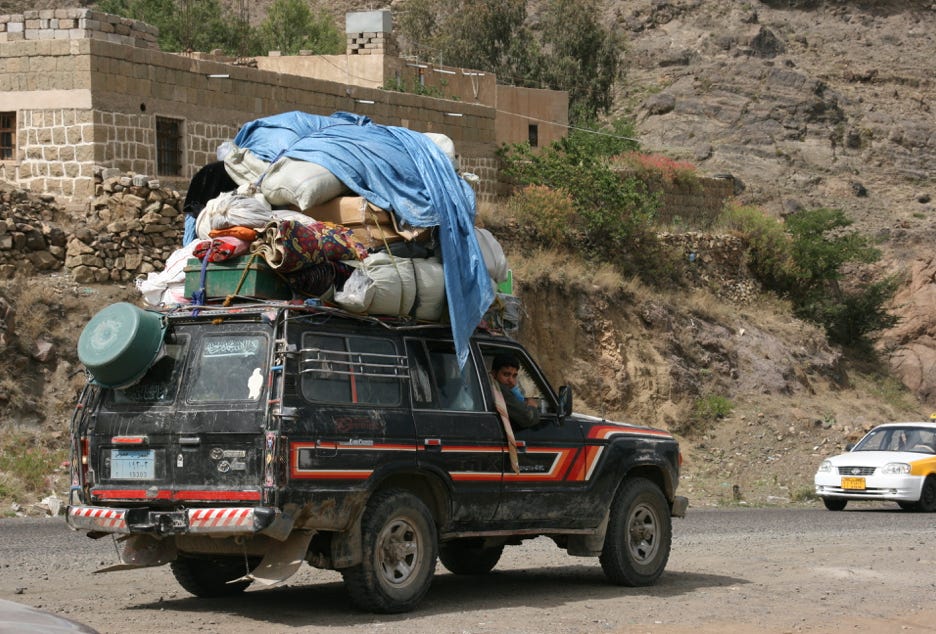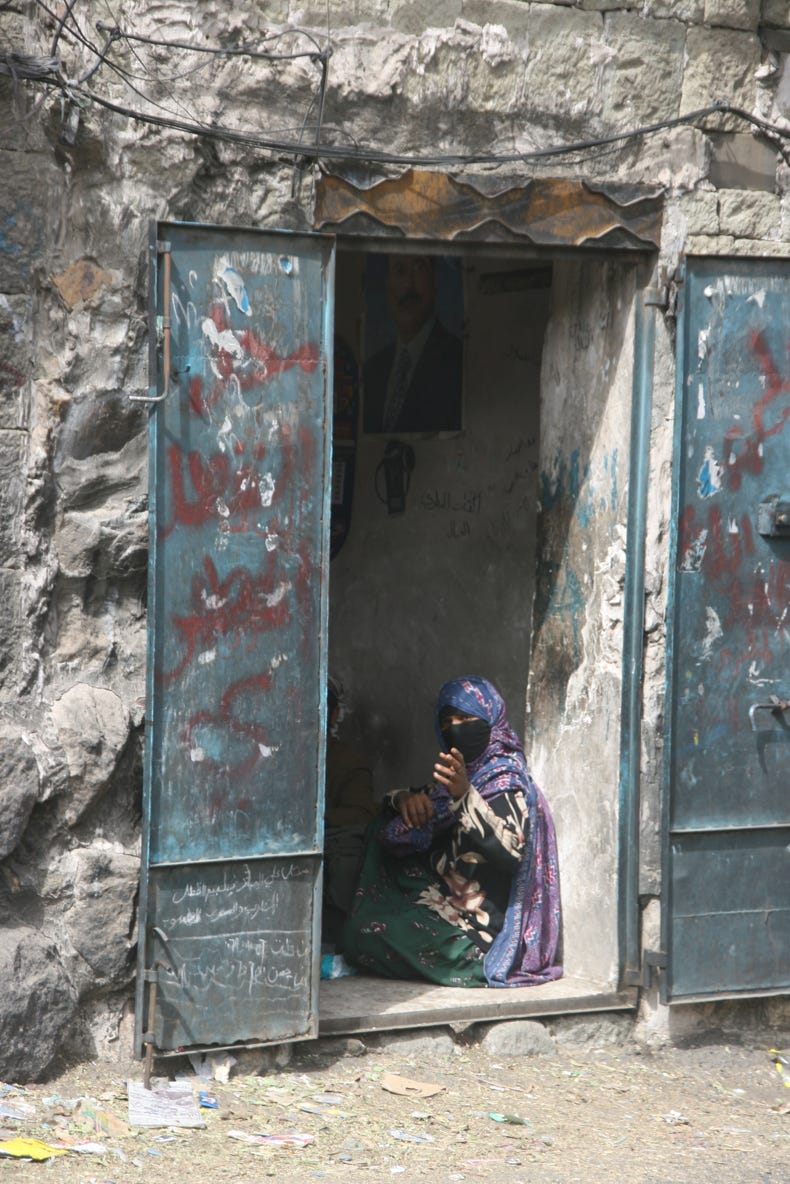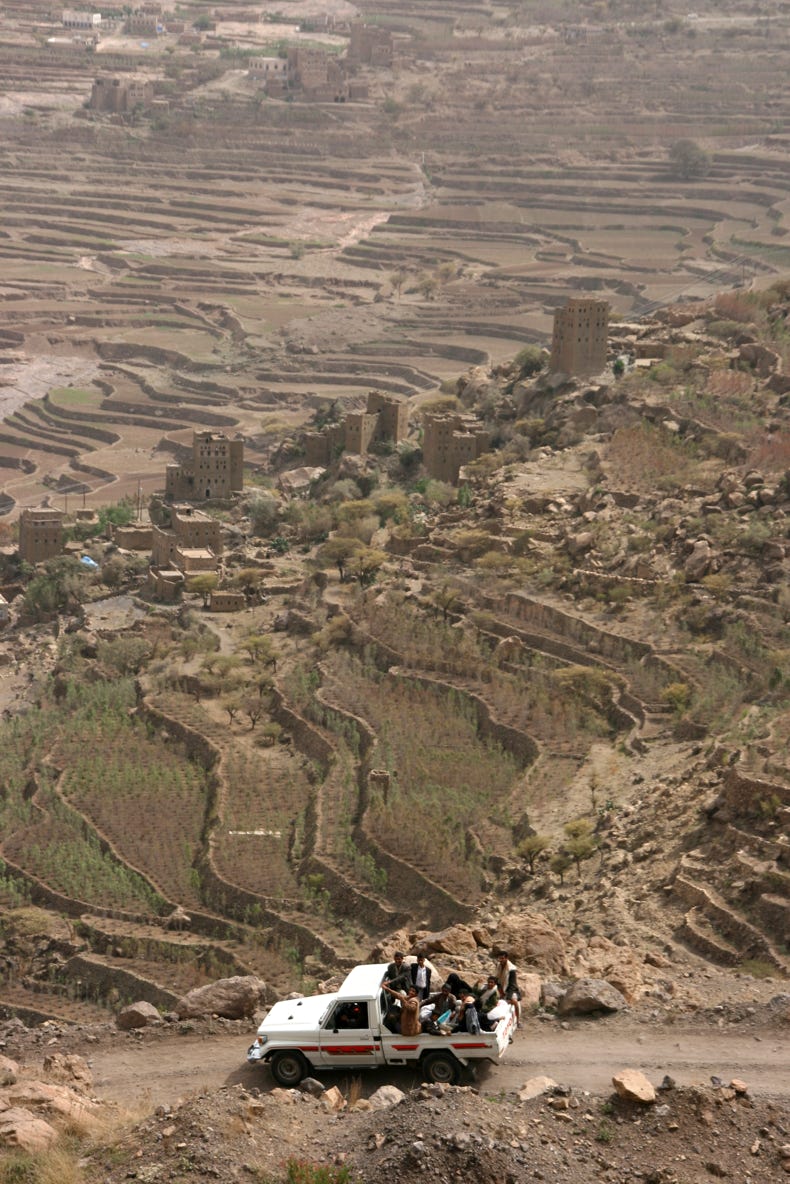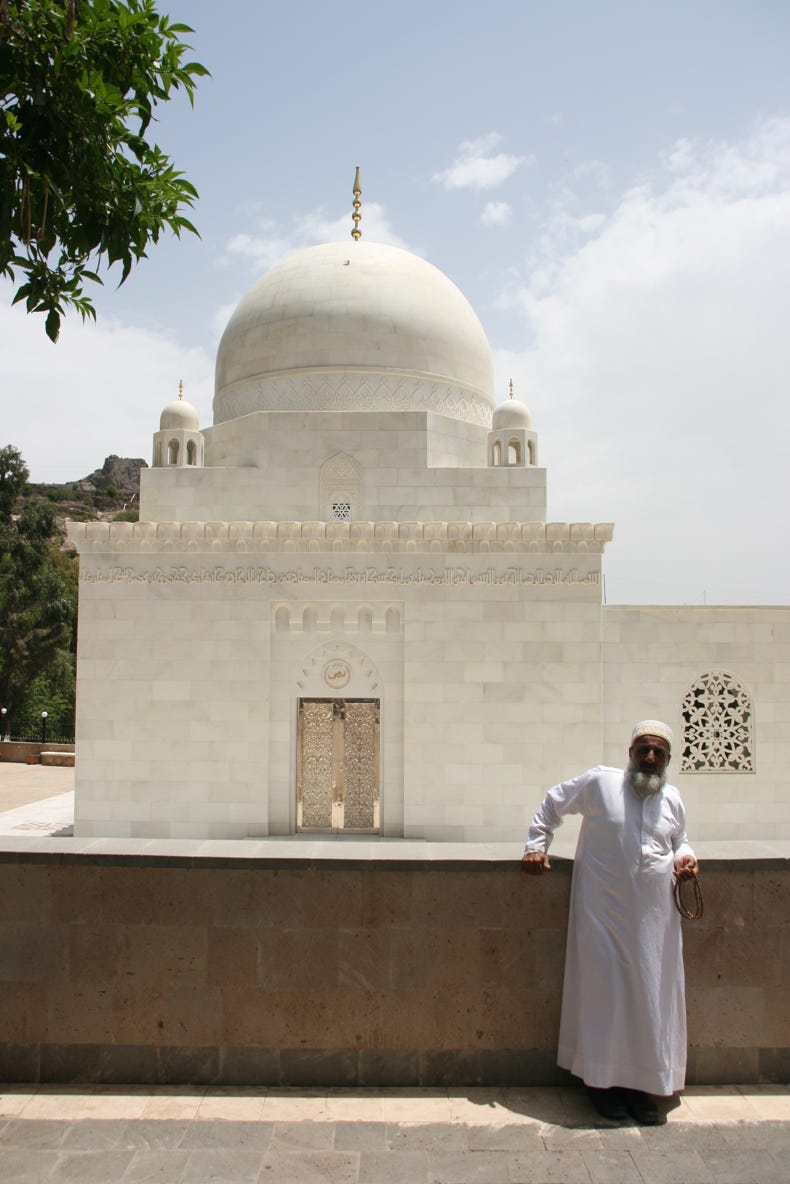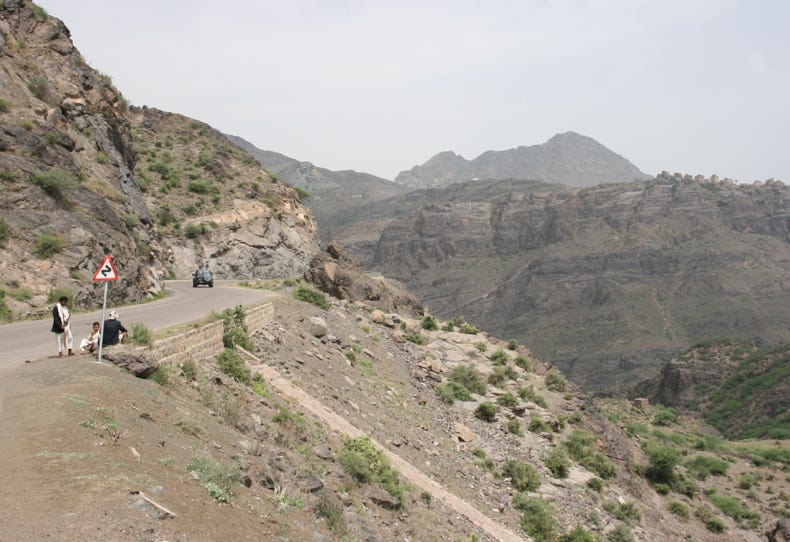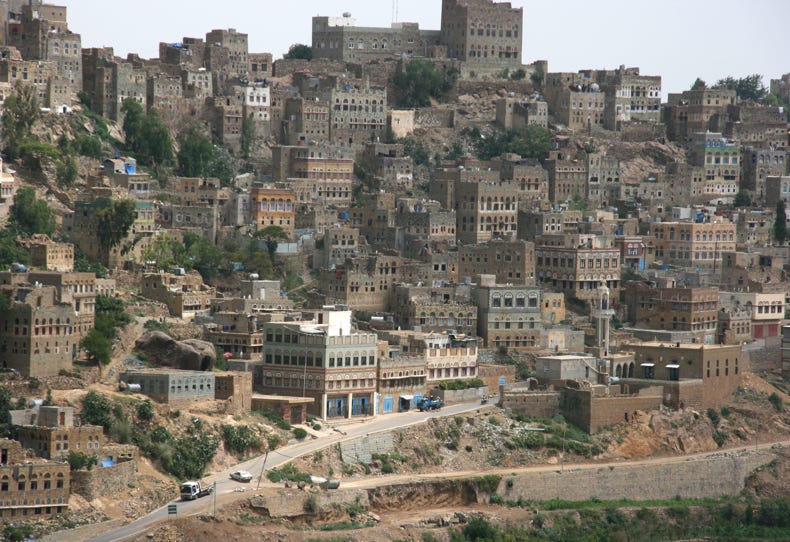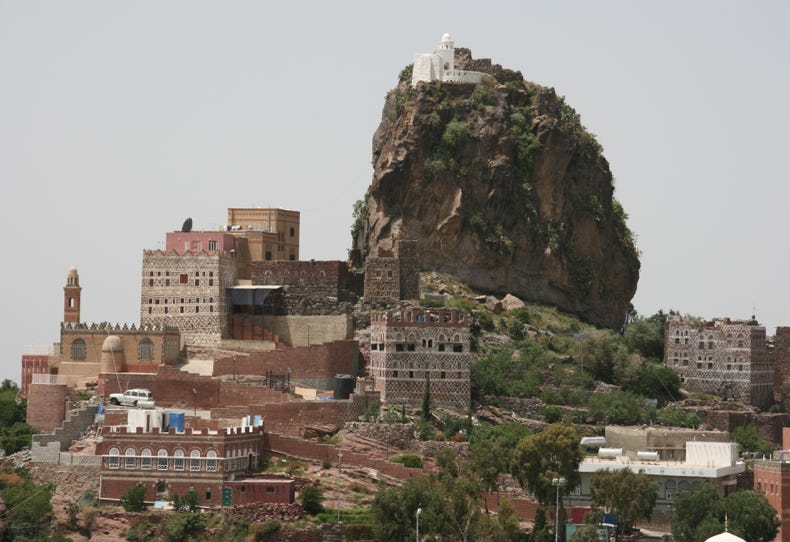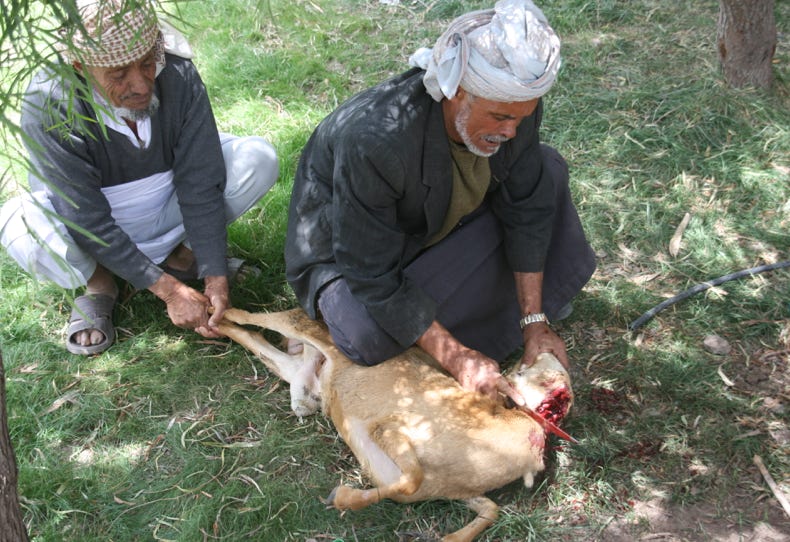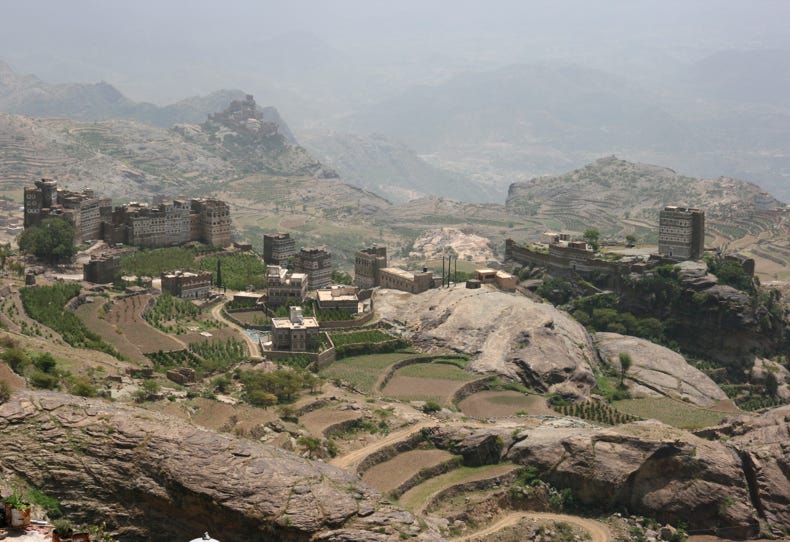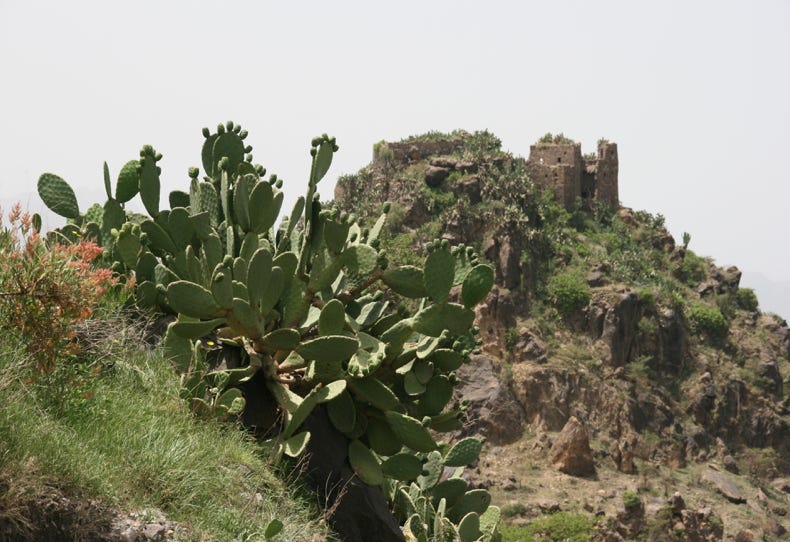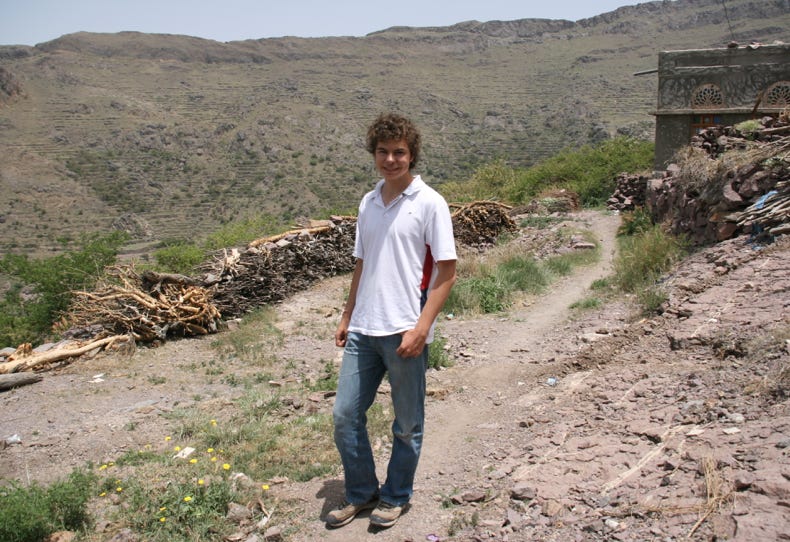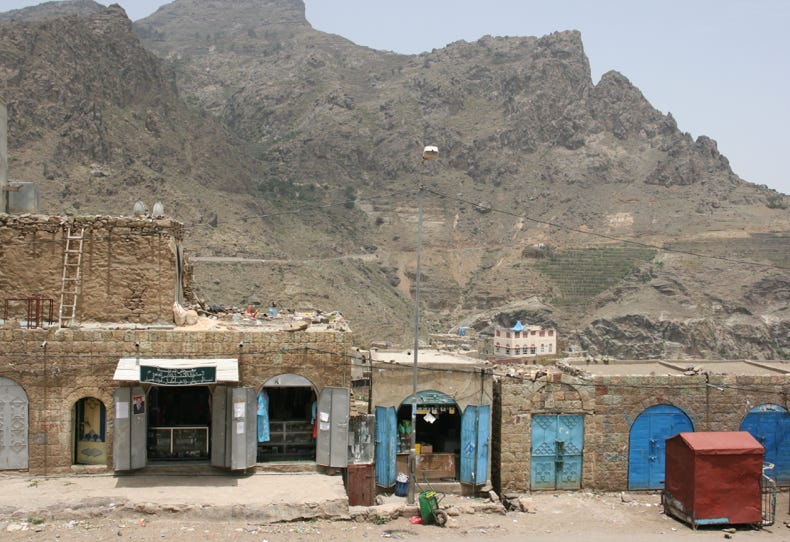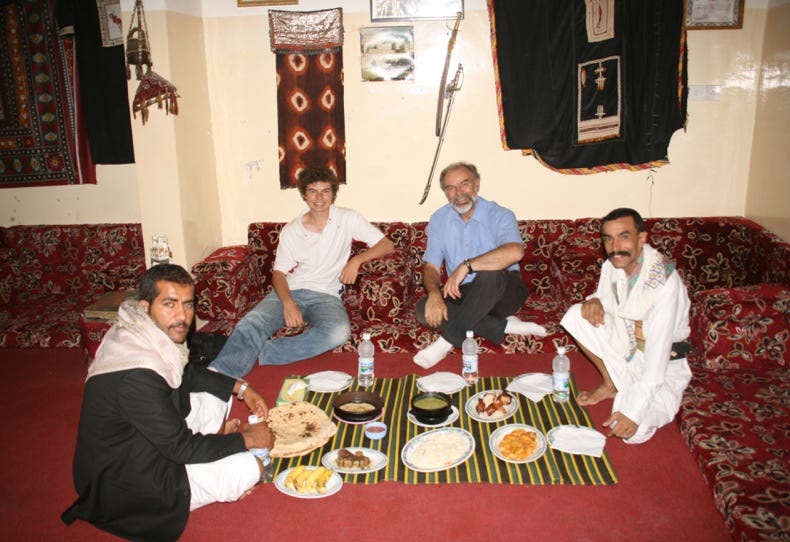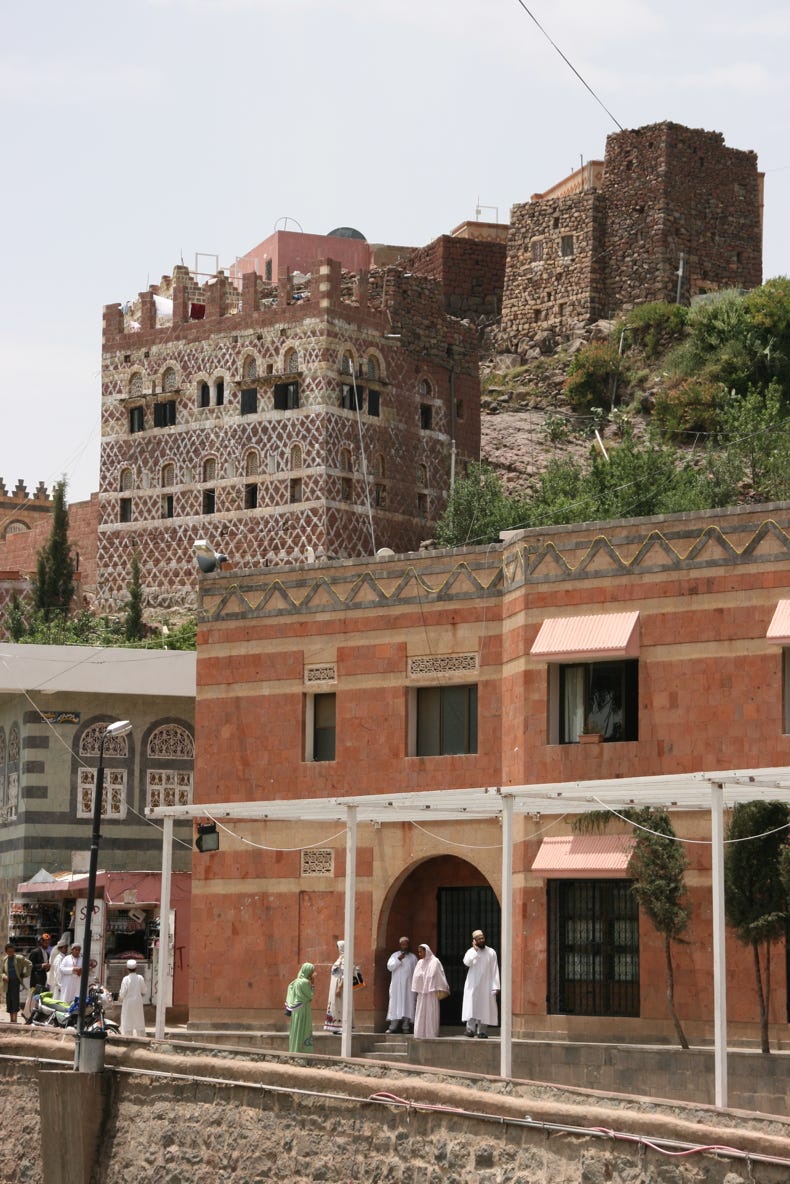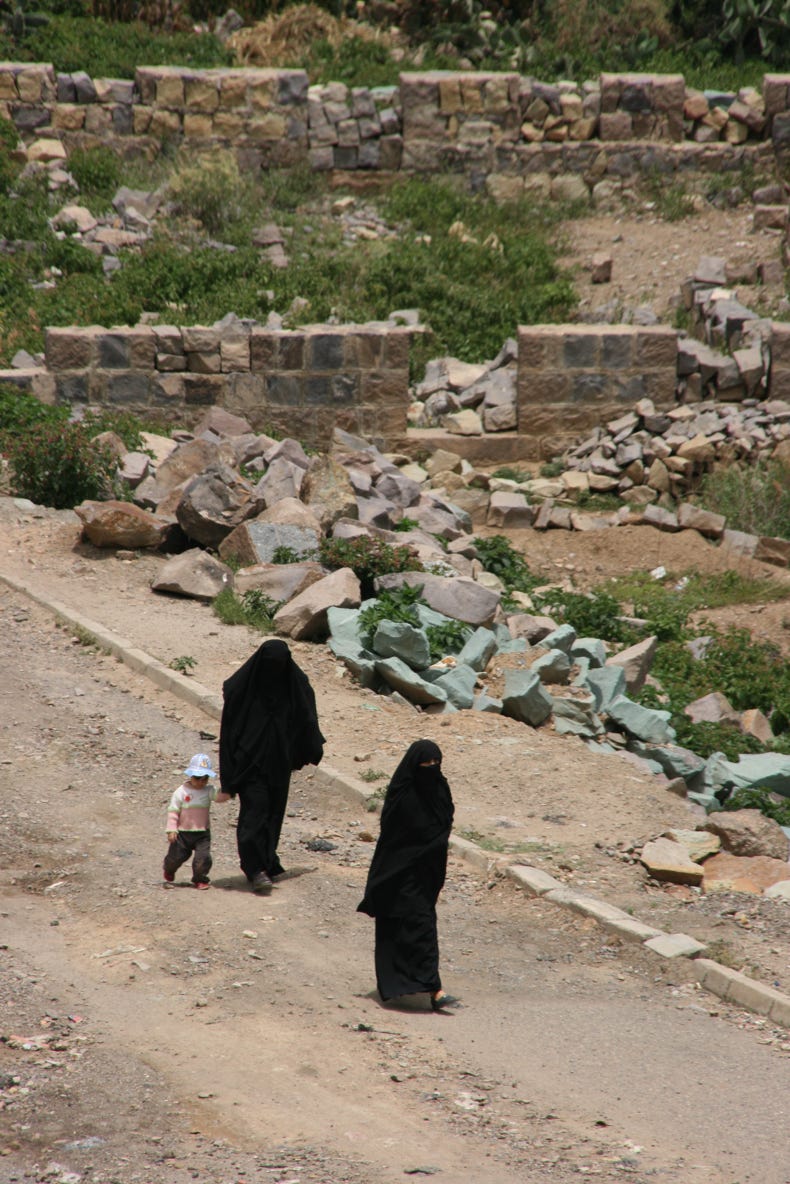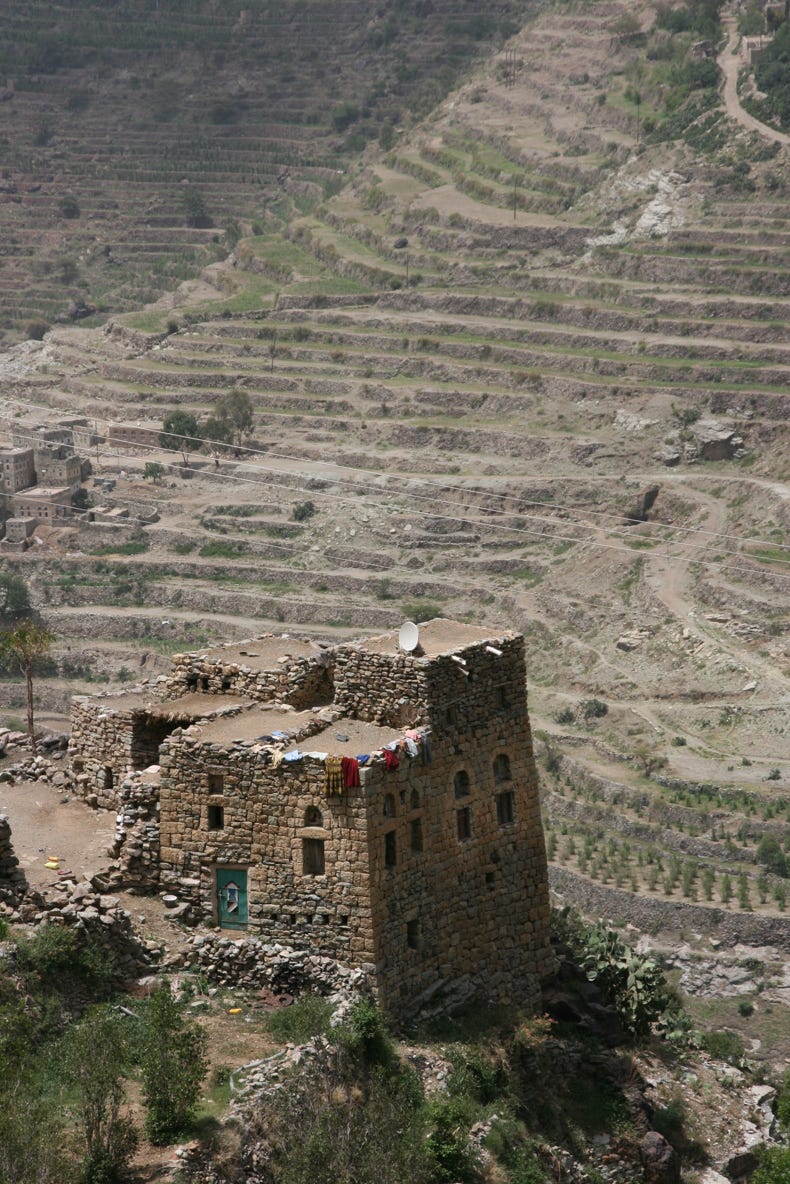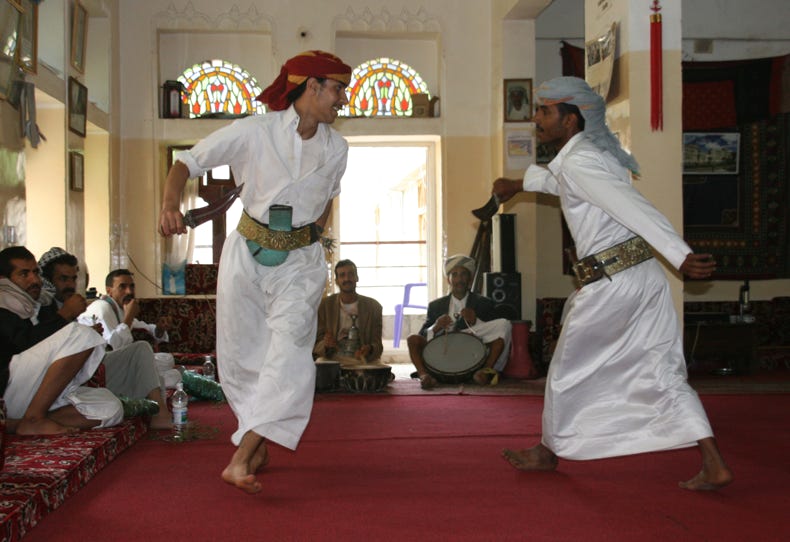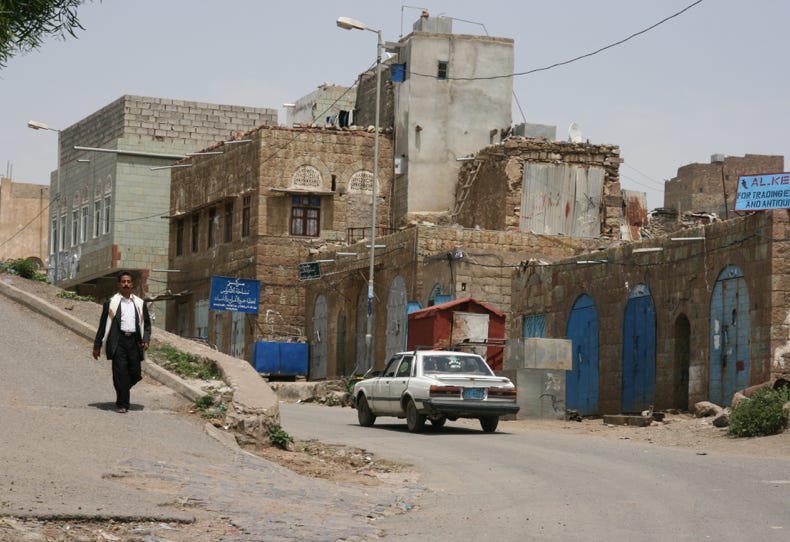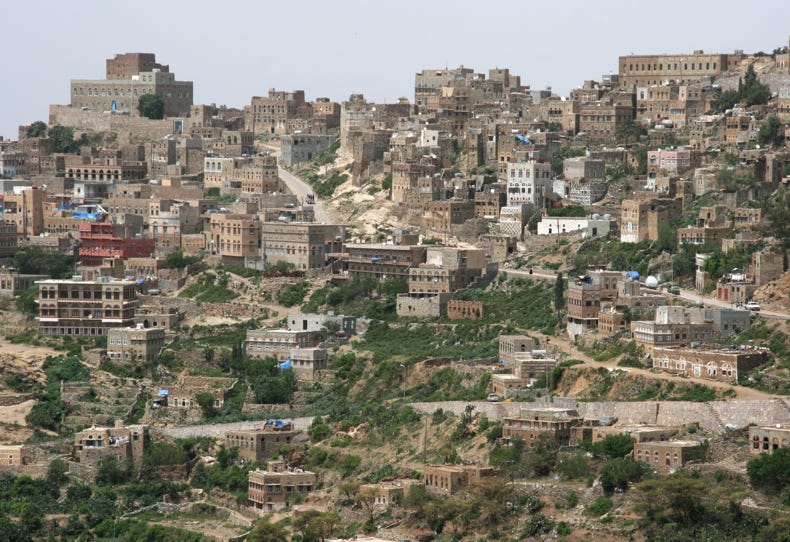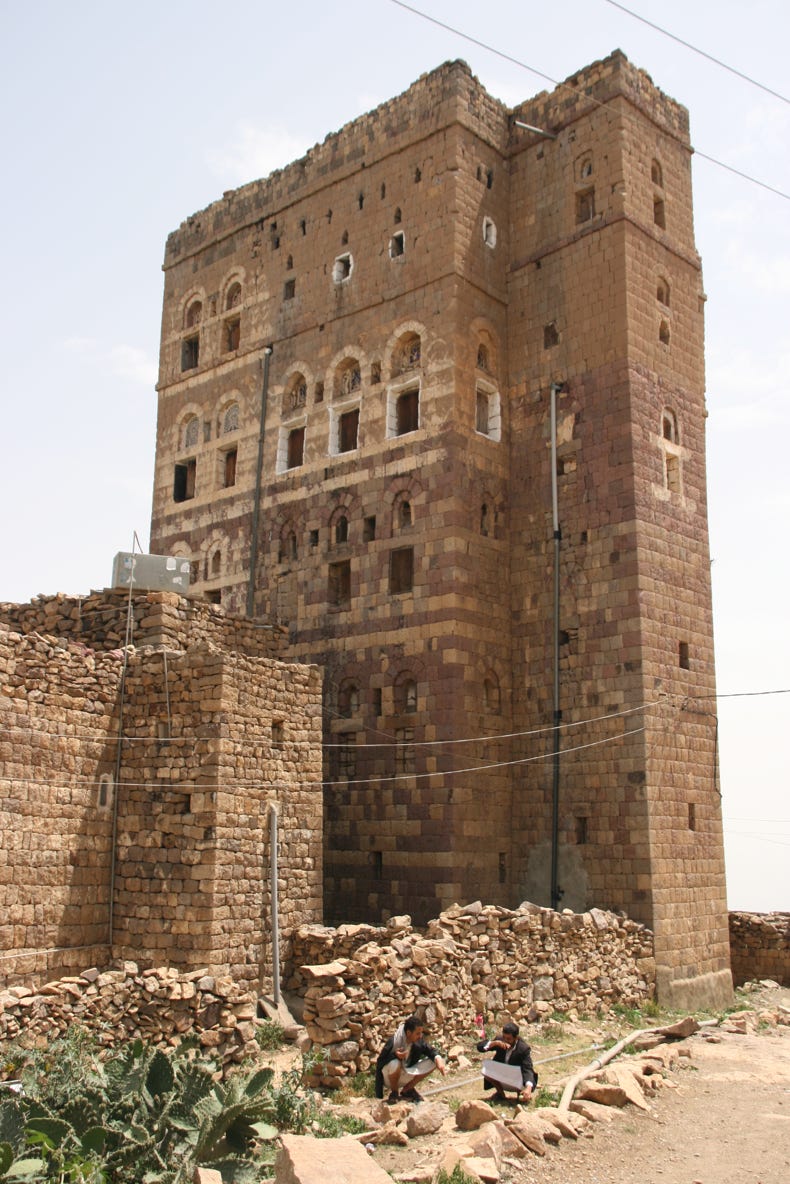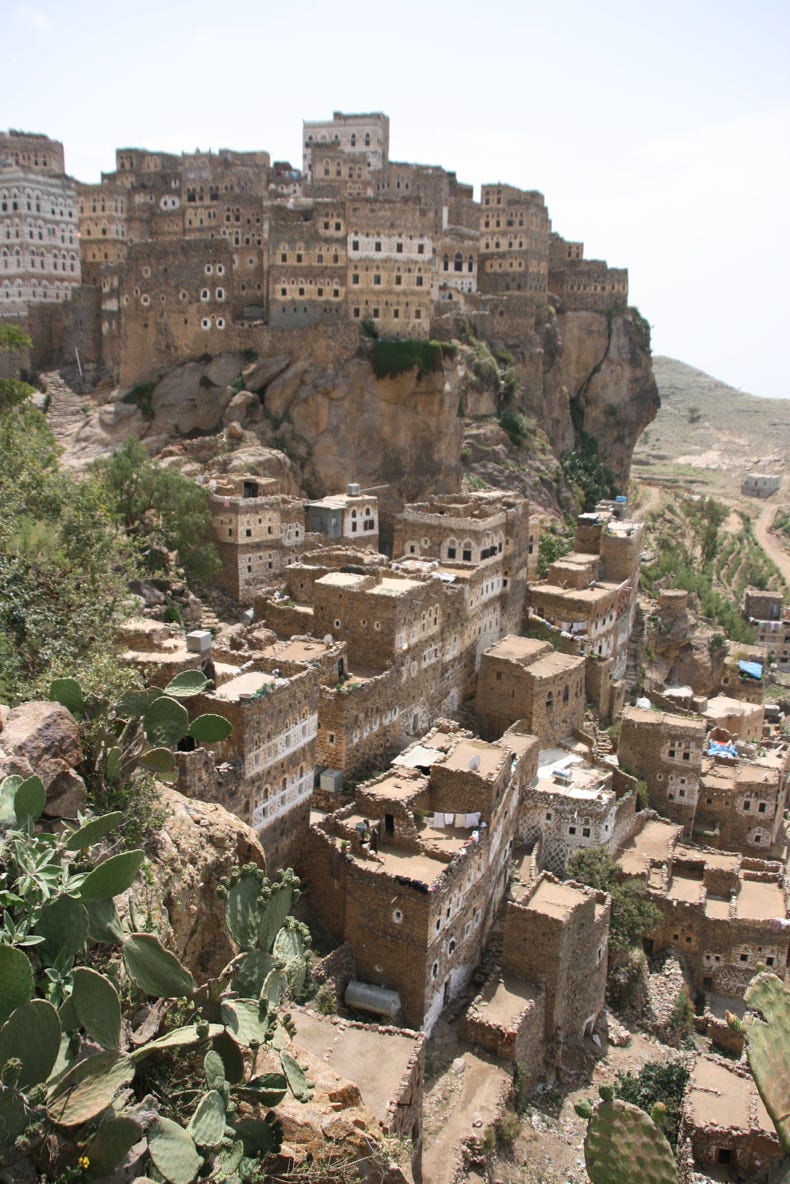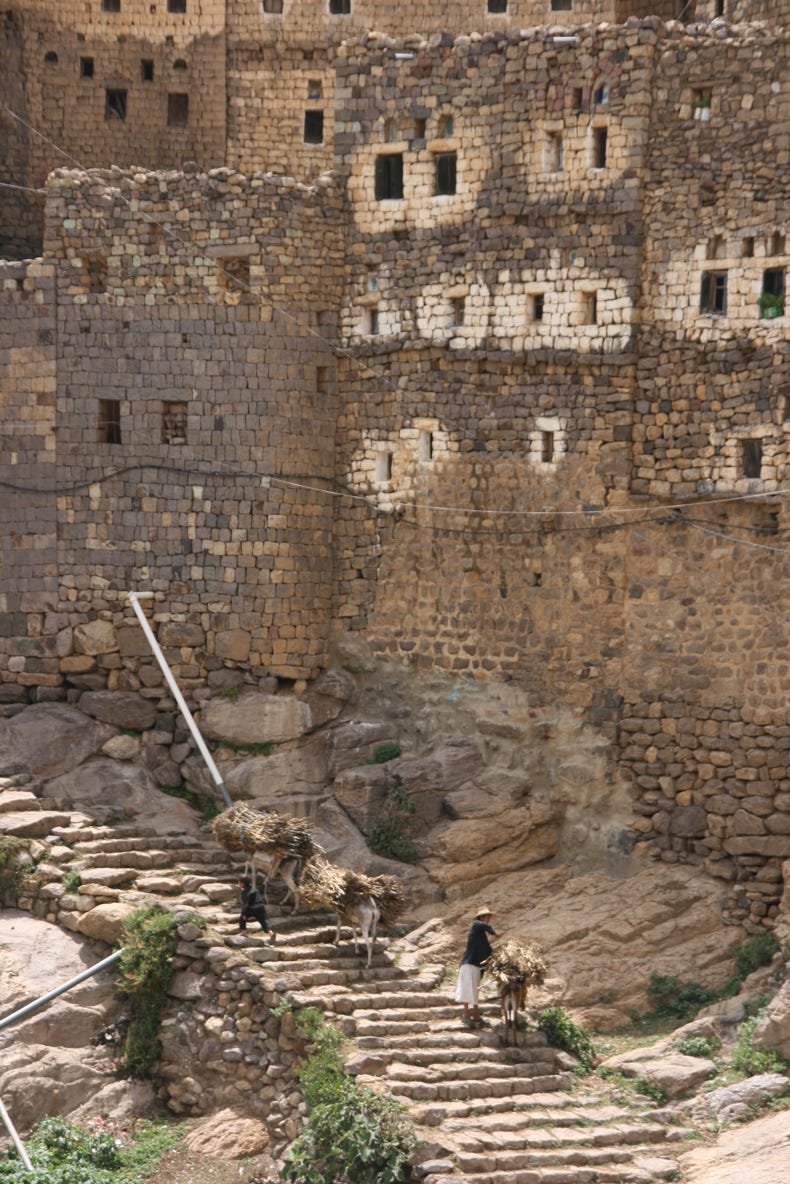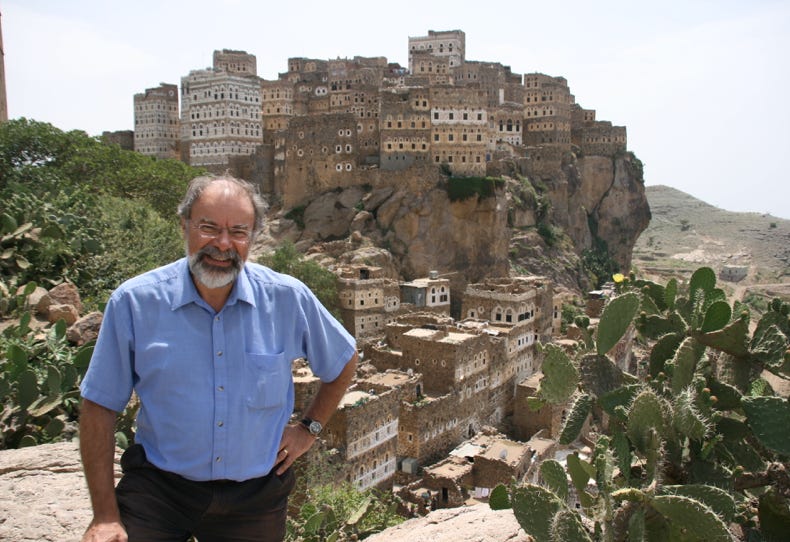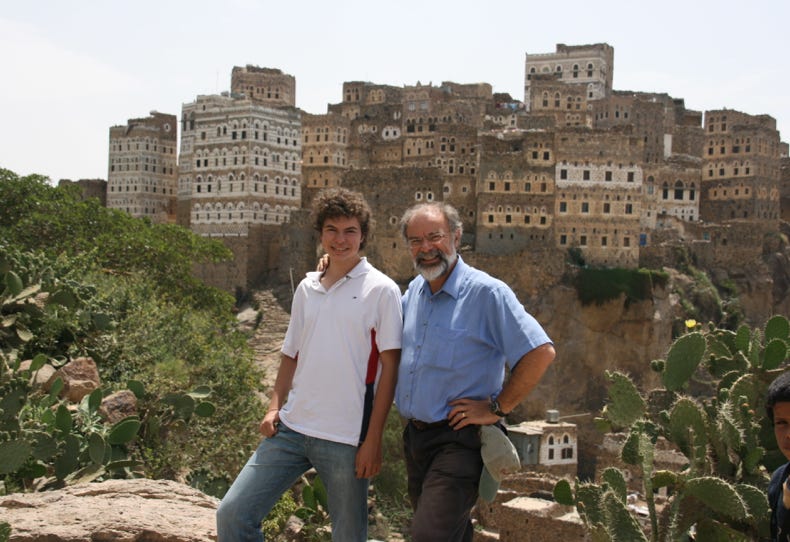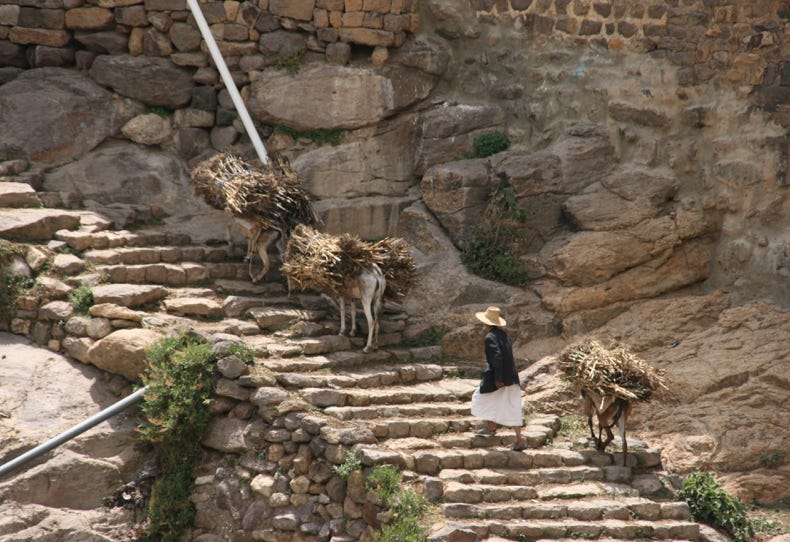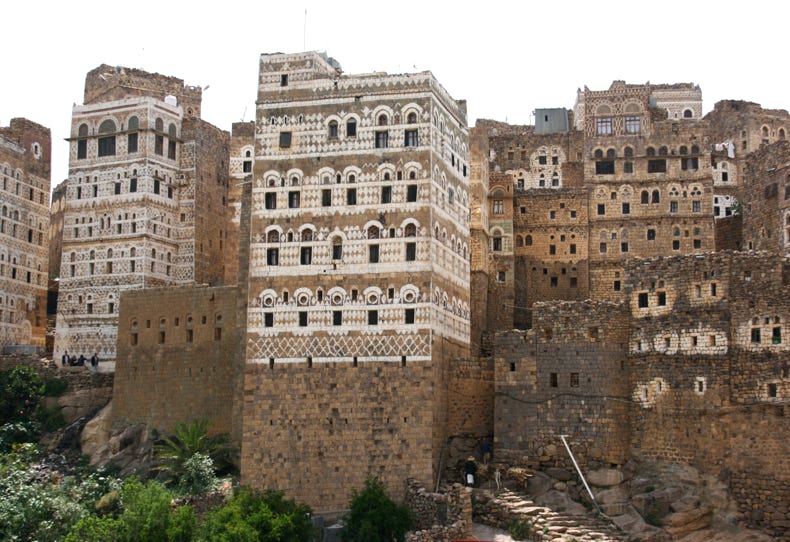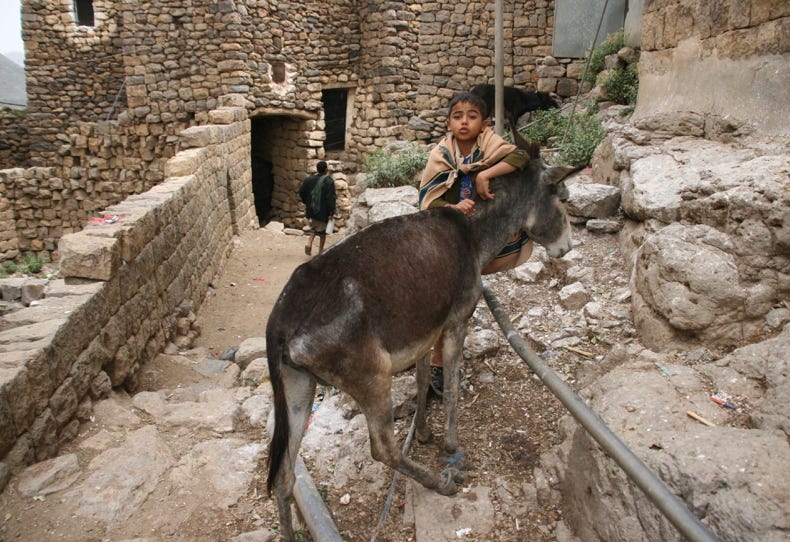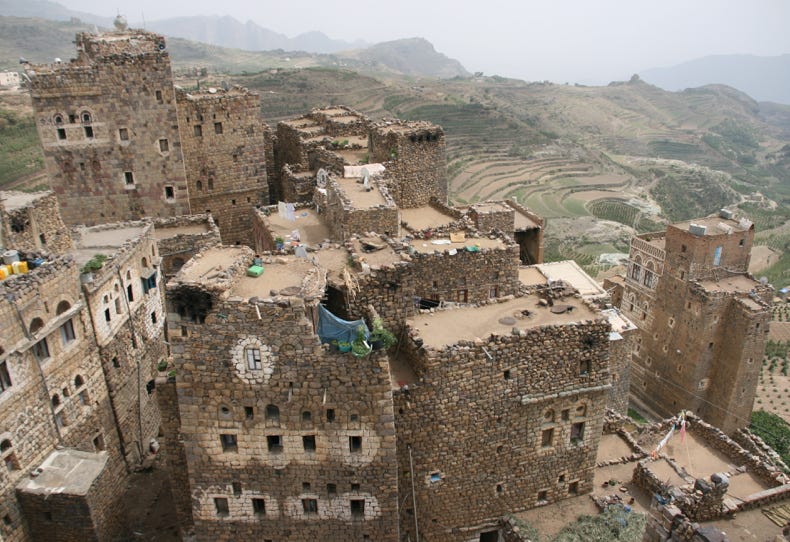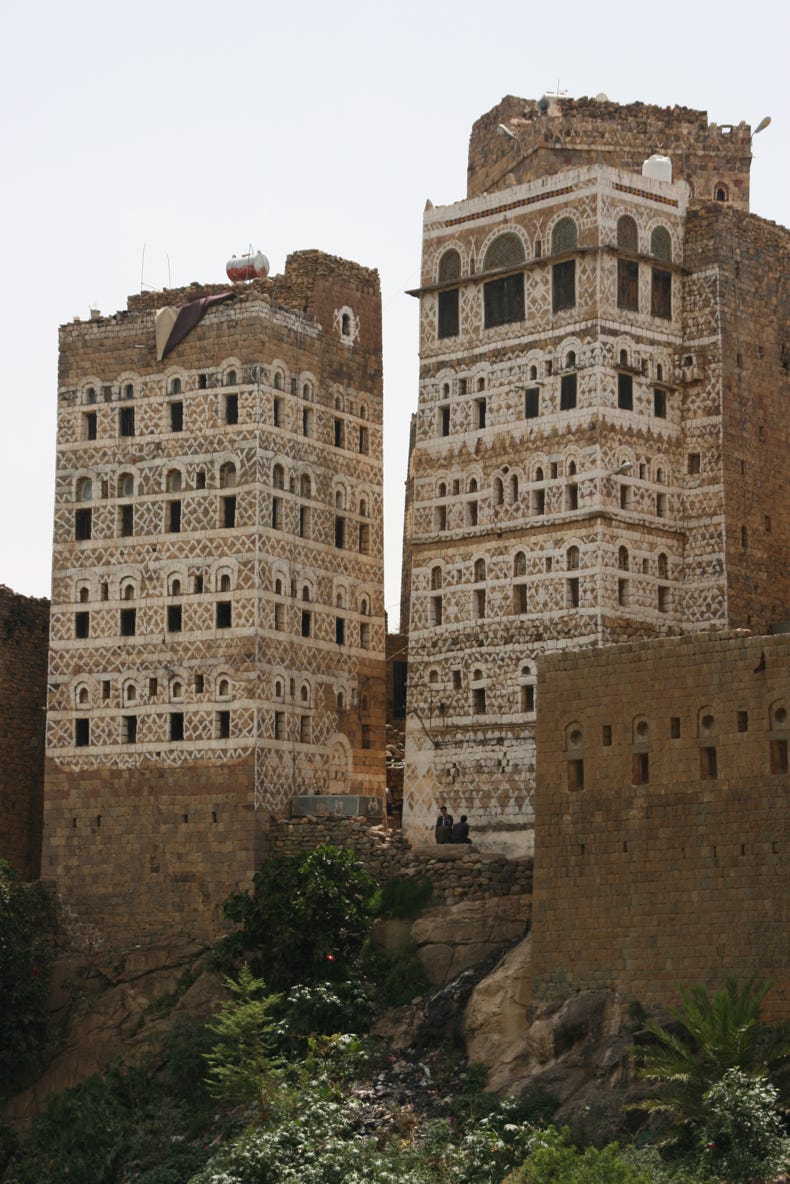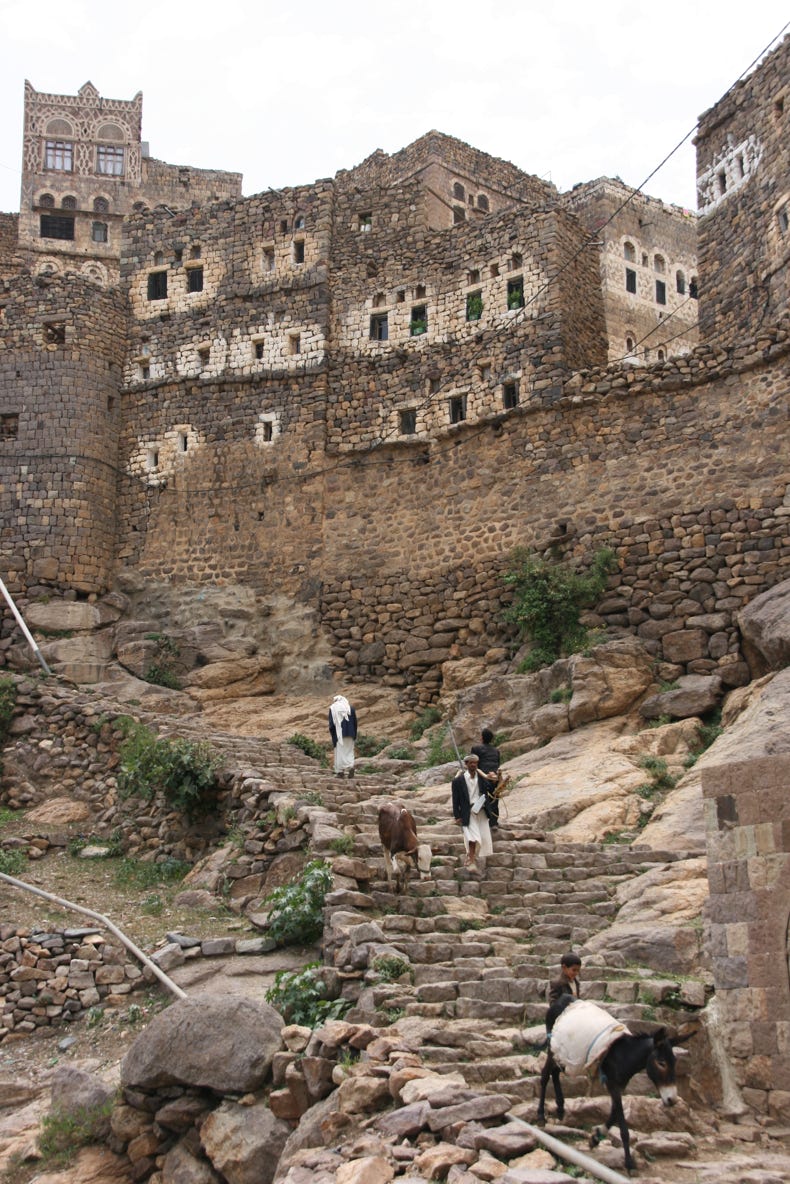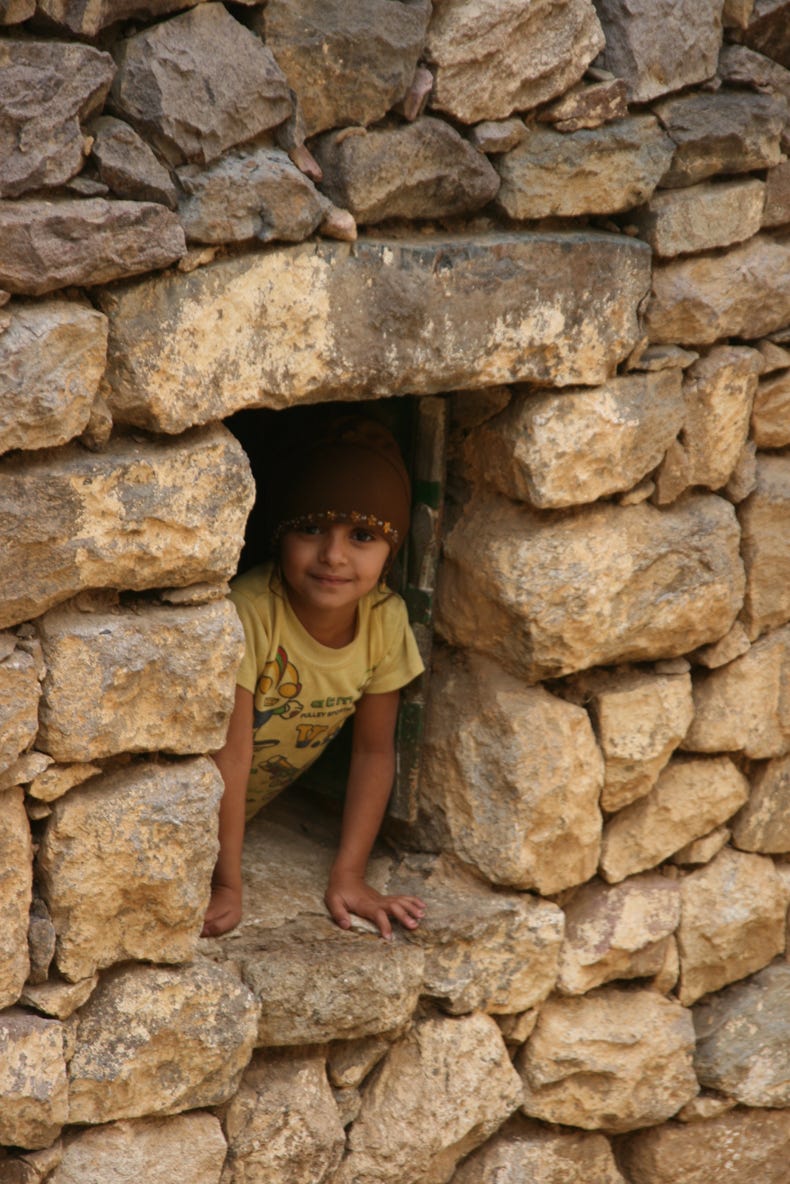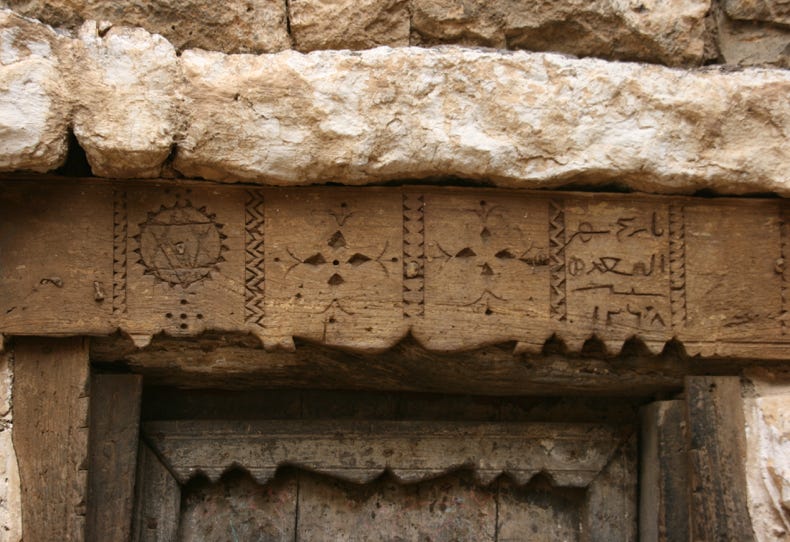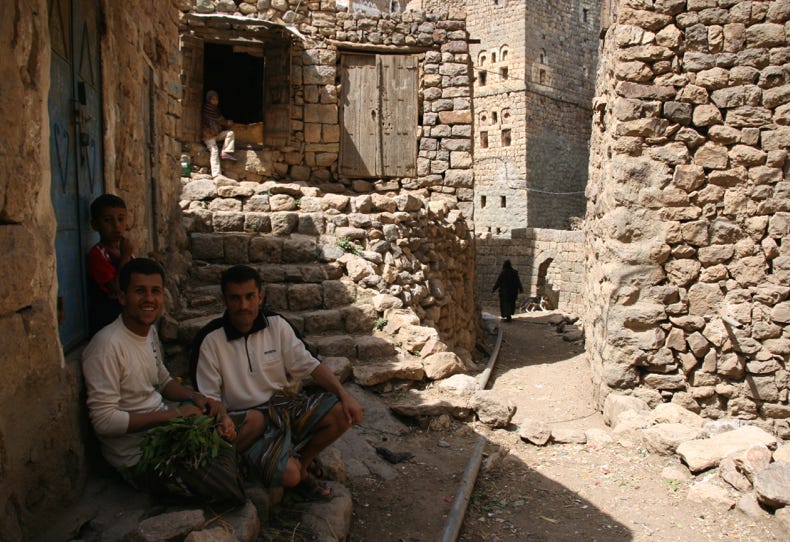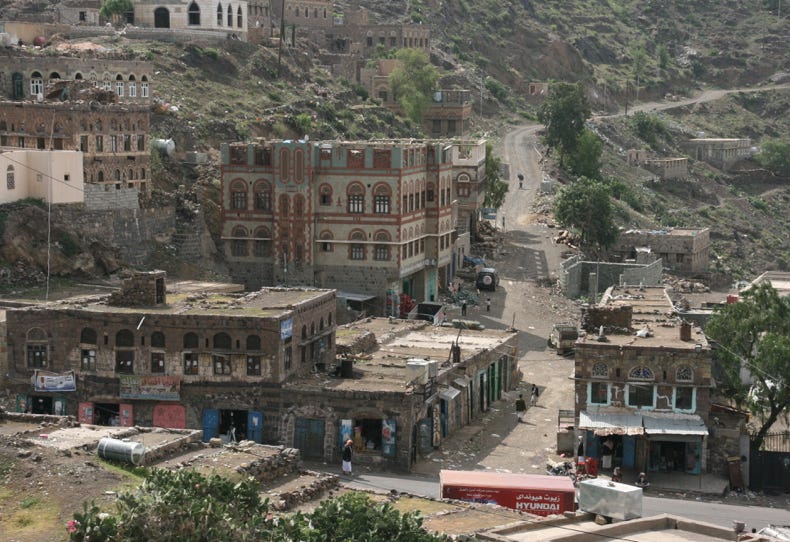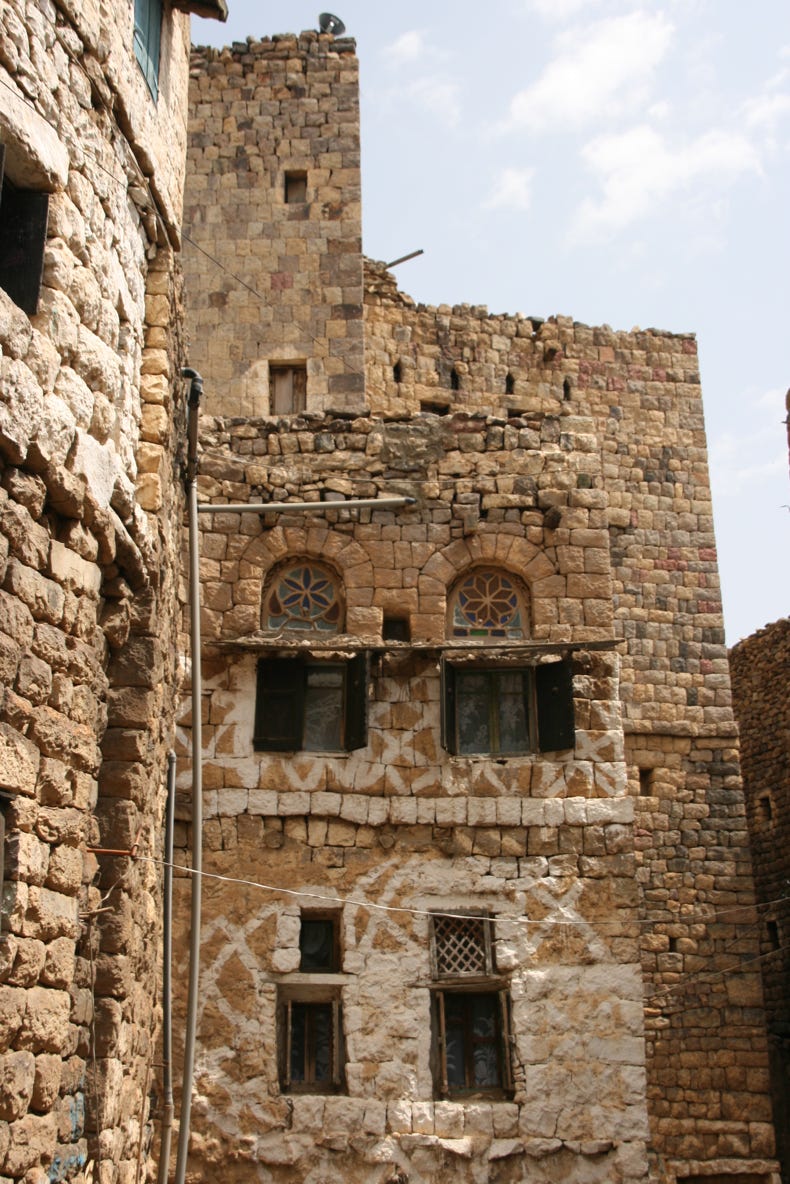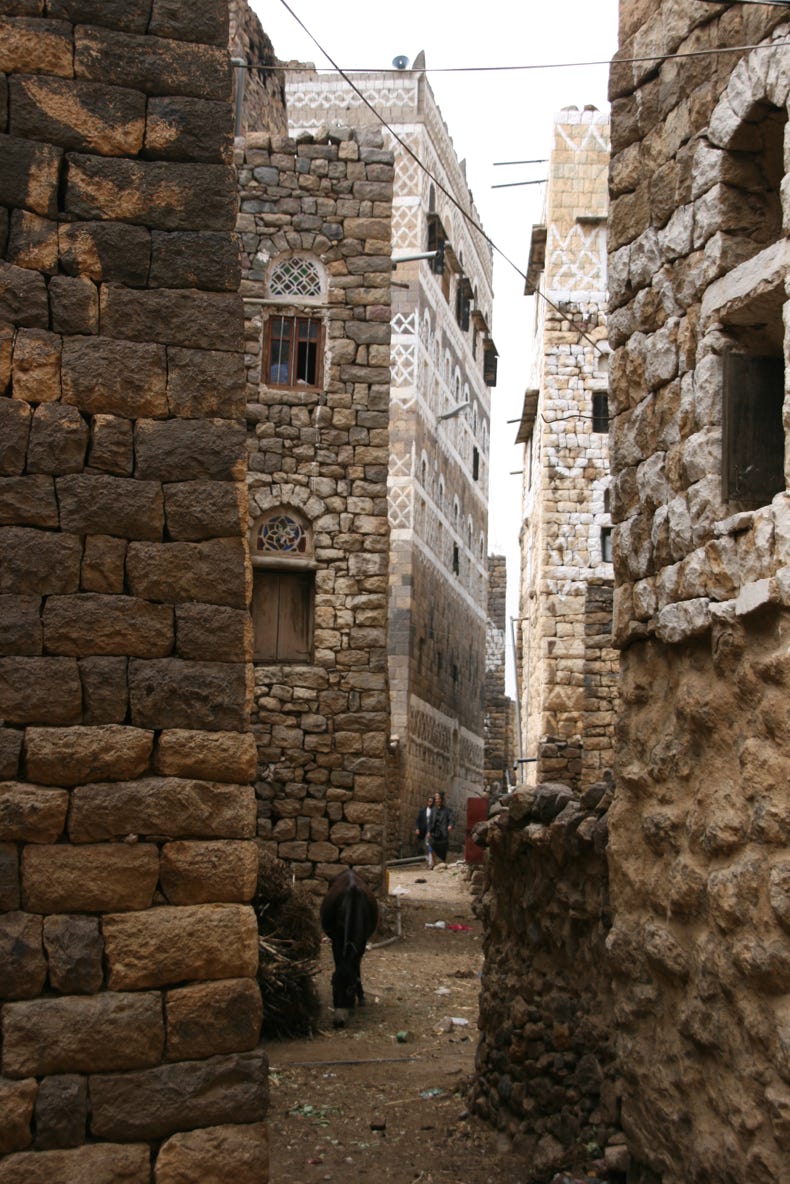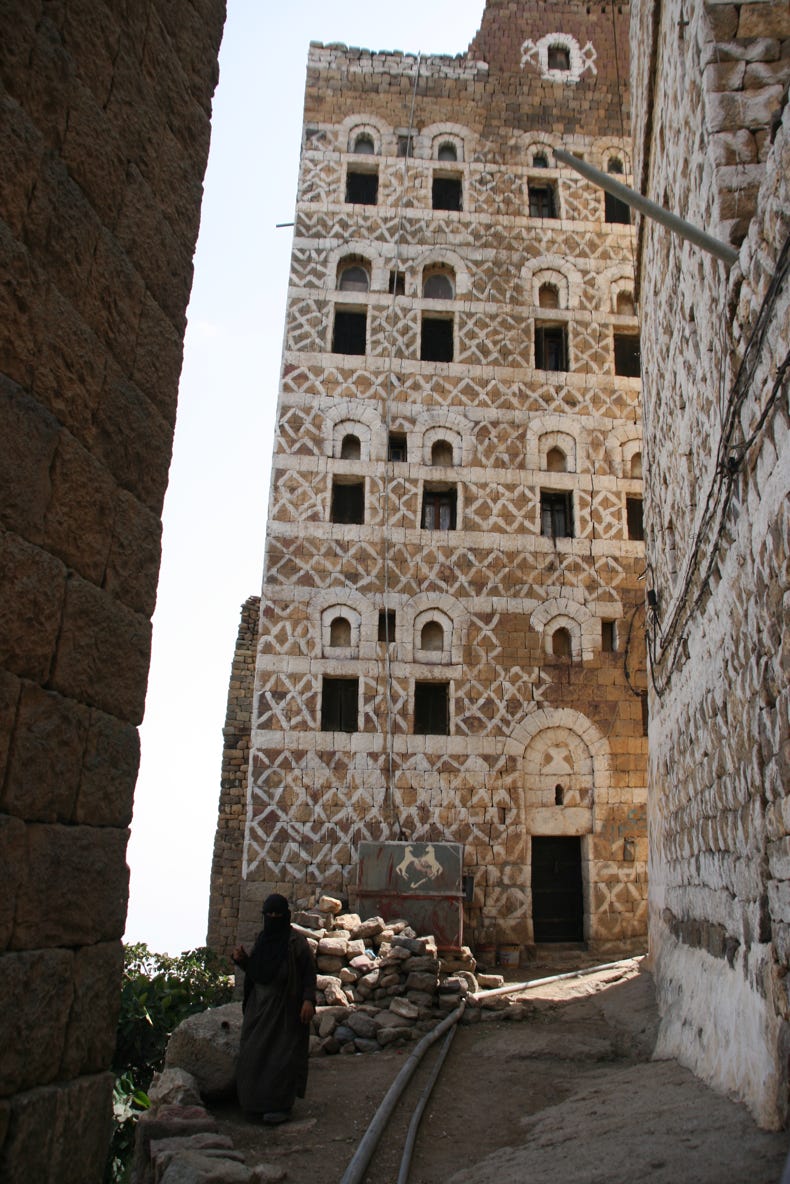

The overwhelming aroma in the air when I woke this morning was dust. The sky was filled with the grey-brown colour of airborne dust, but I didn’t need to look at the sky to know this – I just needed to inhale. Notwithstanding the dust, the view from the rooftop of our hotel, where we had breakfast, was wonderful; old Sana’a must be one of the great sights (and sites) of the world. Actually, that previous sentence may be a bit misleading. We were told that breakfast would be on the rooftop terrace of the hotel, but after waiting there for a while, snapping photos, and finding there was no-one else around, I decided to check downstairs whether there had been a mistake with the time. The reply was “no mistake with the time, sir, but you need to go to our OTHER roof”. The ‘other’ roof was a much lower terrace on an old side-wing of the hotel that we had not known existed, where we found a very pleasant buffet breakfast (if not nearly such a good view) waiting for us.
If dust was the pervading aroma, the pervading sound has been the calls to prayer from the mosques. We have many mosques around us in the old city, and judging by their frequent and quite long calls to prayer, they seem to be very active. Some of the calls to prayer have been so loud and fervent that they echo and reverberate against the stone walls of the houses in the narrow streets of the old town.
Our plan today was to travel with a driver to the Manakah region, a mountainous area over a hundred kilometres west-south-west from Sana’a. Having read the reports about armed car hijackings that can occur in Yemen, I left my wallet, passport and cards at the hotel – just in case.
I need not have worried. Everyone we met was extraordinarily friendly and welcoming (this has been our constant experience in Yemen), and in any case our driver, Abdullah, was not only carrying his knife like every well-dressed Yemeni man, but also a pistol in a holster at his side. Security is obviously an important thing in Yemen, as shown by the three heavily armed road blocks we passed through on the road from Sana’a to Manakah, which had not only officers armed with machine guns and protected by bullet-proof vests, but jeeps with machine guns, armoured personnel carriers, and in the case of one hill that we passed, a tank.
The scenery we passed through to get to Manakah was dramatic and magnificent – there are few other words that can describe it. The entire drive was on sealed road of good quality, but because of the rugged terrain consisted of twists and turns that in some places meant the road completely doubled back on itself. At one stage, the road climbed through a pass that exceeded 3100 metres in altitude, at which point the summit of Yemen’s highest mountain (Jabal an-Nabi Shu’aub, 3660 metres) could be seen clearly.
On reaching the Manakah district, our first stop was the village of Al-Hudhaib, centred on the hilltop mosque of the same name.This is a pilgrimage site for Muslims of the Ismaili sect, and we were told that every year large numbers of pilgrims come from India. Upon arrival, we met the imam who offered to show us around (although not inside, of course, as that area is accessible only to Muslims). We had to wait for a few minutes while he said some prayers as a goat was sacrificed (see above right), but he then happily showed us the various facets of the mosque. After saying goodbye to the imam, Andrew and I continued to walk around the tracks at the foot of the rock pinnacle, past some spectacular prickly pear growth to see the surrounding valleys, the sides of which were covered in extremely well constructed and stable terraces.
After exploring Al-Hudhaib, we took the short 6 kilometre drive into the main town of the district, known as Manakah. We sat on floor-level cushions to have a traditional Yemeni lunch in a small hotel, the lunch comprising rice, potatoes, a piece of grilled chicken and Yemeni bread that was used to dip into a spicy green hot paste made from beans, all washed down by a very welcome bottle of cold water. After lunch, two of the hotel owner’s sons gave us a spontaneous demonstration of a traditional Yemeni dance, the focus of which seemed to be avoiding each other’s knives in the midst of fast, energetic, extroverted movements. Lunch was quite a prolonged process lasting two hours, partly because our driver and his friends wanted to relax chewing some of the gat that the driver had stopped on the way from Sana’a to Manakah to purchase (from a small roadside stall where the seller was proudly displaying his semi-automatic sub-machine gun – gat is obviously a valuable commodity in Yemen).
Having finished lunch, we drove 5 kilometres to the final village we would visit in the Manakah region, the spectacular hilltop village of Al-Hajara. This small village was originally started by the Turks during the 11th century. The location was chosen for defensive purposes, and even today there is only one access gate into the village. At one time, there was an extensive Jewish presence, but all the Jewish people left and moved to Israel in the 1950s. The village comprises old stone and whitewashed tower buildings, some of which are up to eight storeys in height.
When we arrived, we were approached by many children and young men wanting to be our guides. Despite our best efforts, we had an entourage of 6 to 8 ‘friends’ to show us around, and although they could not help but get into many of our photos in the narrow laneways of the village, they did make sure that we saw all the important sights (and often had some arguments among themselves as to whether something was worth seeing or not). One of our ‘friends’ was the youngest son of the village leader, who occupied the highest house at the top of the hill, and he invited us up to the roof for a great view looking down on the village and its surrounding valleys. The village residents were extremely friendly and hospitable, and it was great to sense their pride in their home village as they showed us almost every pathway, step and laneway that could be accessed.
We finished our walk around Al-Hajara at about 3:15 pm, by which time it was time to head back to Sana’a. We were glad that we had taken so many photos of the mountain scenery on our way to Manakah because the return journey was undertaken under heavy clouds that completely deadened the vibrancy of the landscape. In fact, at one stage, we drove through a heavy shower of rain, something that is quite rare at this time of year in this very semi-arid area.
After relaxing for a while in our room, we headed off to the Arabia Felix Backpackers Hotel for dinner. Although at times our conversation was difficult because the calls to prayer from the nearby mosque were so fervent, we had a thoroughly enjoyable meal; Chicken in Lemon for Andrew and Mixed Grill for me, followed by yogurt with honey for dessert for both of us.
We had to try and get an early night because we were due to check out from the hotel and 7:30 am the next morning. We didn’t quite manage an early night, but it was at least earlier than the previous evening. Thankfully, it was also a bit cooler, making sleep with the window open much more pleasant - if somewhat more difficult because of the cacophony of noise drifting in from the mosques and the laneways outside.
